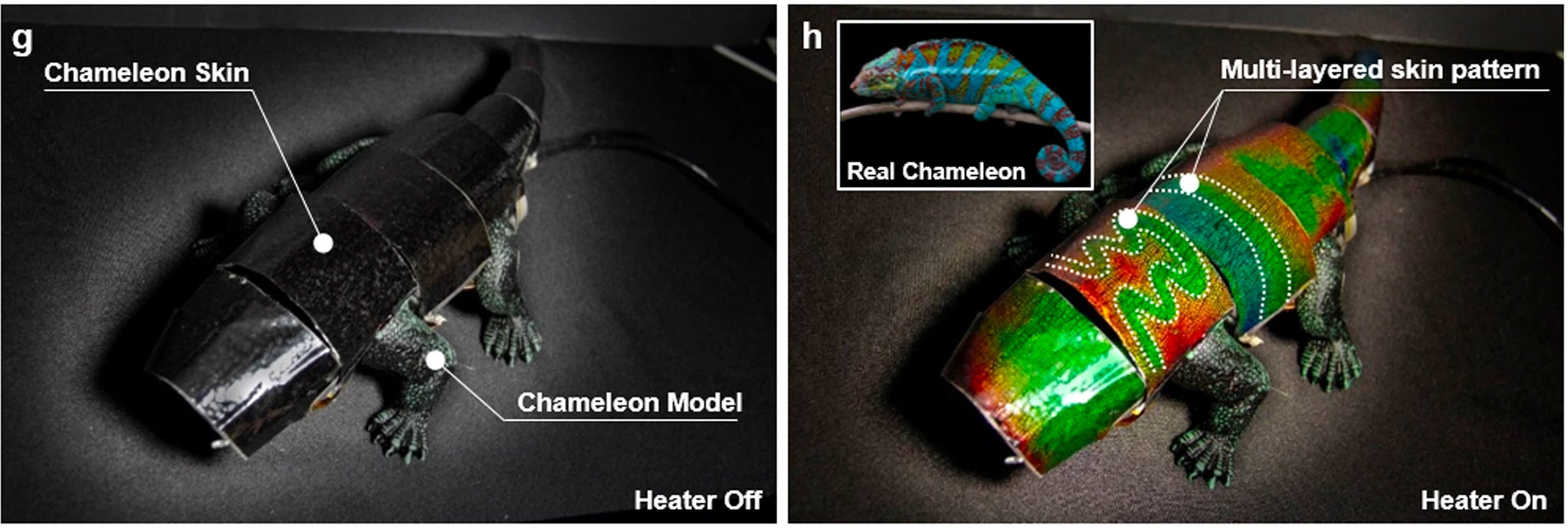Creatures like chameleons and cuttlefish can effortlessly change the colours and patterns of their skin to match their surroundings, but recreating that clever camouflaging trick on a robot required some impressive engineering from a team of South Korean researchers who have now given robots the power to hide from us. Wait, did we think this all the way through?
Cuttlefish are able to change their appearance by contracting muscles in their skin that changes the size of tiny coloured cells called chromatophores so they become more or less visible, similar to how coloured pixels on a screen light up and dim to create a larger image. Chameleons do their camouflaging a little differently, with a layer of skin containing pigments and an underlying layer made from cells containing guanine crystals. As the spacing between those crystals changes when muscles flex, the wavelength of the light that’s reflected also changes, producing different colours the chameleon can match to what’s around it.
Both approaches represent some of Mother Nature’s most clever approaches to stealth and safety. The camouflaging tricks make it hard for both prey and predators to spot these creatures, but the mechanics of how they work are still well beyond our engineering capabilities. The most obvious approach to creating adjustable camouflage is to leverage the flexible flat panel display technology included in devices like Samsung’s Galaxy Fold smartphones, but those screens are very fragile and only offer a limited degree of flexibility, whereas the skin of a chameleon can easily contort to the shape of the animal without losing its ability to change colour.
In a paper recently published in the journal Nature Communications, a team of mechanical engineers and engineers from Seoul National University and Hanyang University detail a different approach, which bypasses flexible OLEDs for a custom multi-layer artificial skin they designed. It works similarly to a screen with lower resolution and fewer details, but also less fragility.

The top layer of the artificial skin is covered with a thin coating of liquid crystal ink that can display different colours depending on how its molecules align into different structures. Various shades can be produced by mixing the appearance of red, green, and blue, but instead of reacting to the movement of muscles, the orientation of the liquid crystals changes when heated. Beneath the colour-producing top layer of the robo-chameleon’s skin are multiple layers of silver nanowires that become heaters when a current is applied. The team designed custom controllers that can precisely heat the nanowire layers to specific temperatures to produce exact colours needed to camouflage the robot, based on what multiple optical sensors mounted to its underside detect beneath it.
The robo-chameleon can’t perform its colour-changing tricks as quickly as a real chameleon can. It takes about a half-second for its artificial skin to match what it’s walking on, but the researchers believe response times could be improved with the addition of cooling mechanisms to help the silver nanowires and the liquid crystals change their temperature much faster. The robot also can’t match the fine details of its surroundings like a real chameleon is able to, but the researchers have taken into account the varying textures that appear in nature by creating several different patterns the robot can apply to its outer layer — dots, stripes, etc. — that help the colour-changing skin look more natural and better match what’s around it.
There’s not a whole lot of practical uses for a slow-moving robot chameleon, but the research behind it certainly has some interesting potential. The militaries of the world have long been trying to recreate Mother Nature’s camouflaging tricks, and this new research could finally provide a way for military vehicles, and even the uniforms worn by soldiers, to adapt to the colour and pattern of the terrain around them. But it could be applied to regular old cars too, so in the summer a lighter shade would better reflect the sun and heat, while in the winter darker shades could capture the heat to help keep everyone warm inside.
